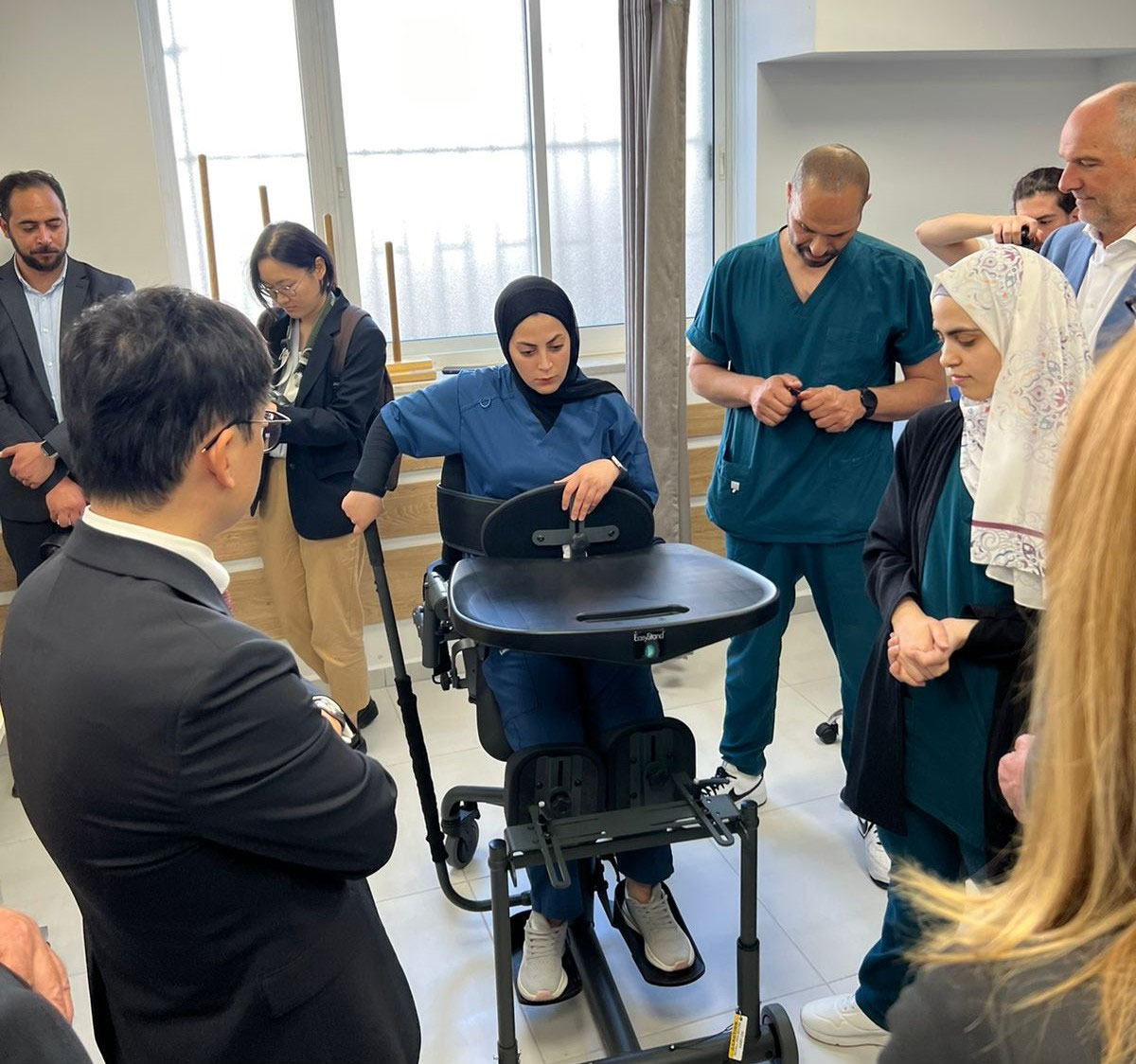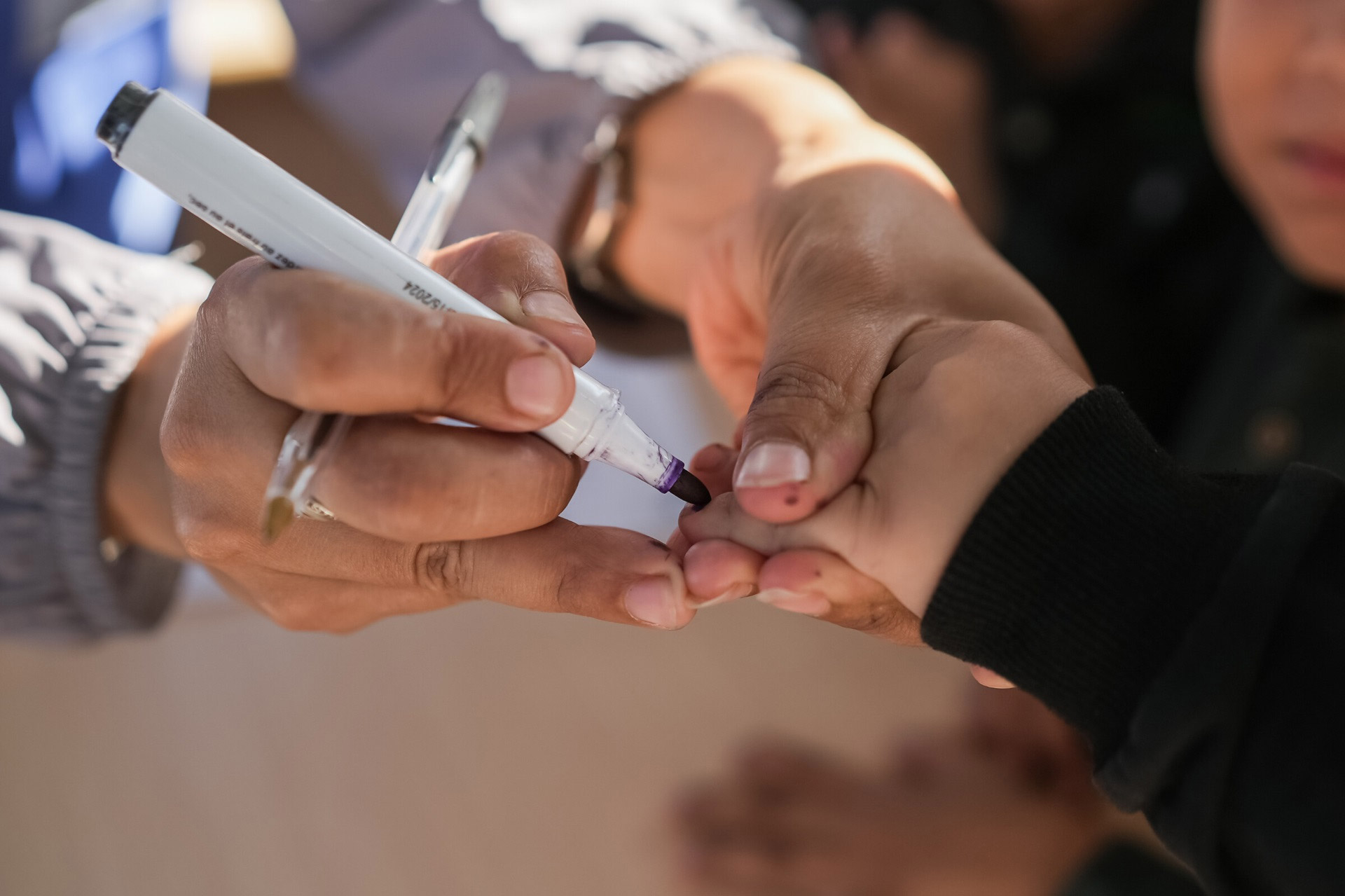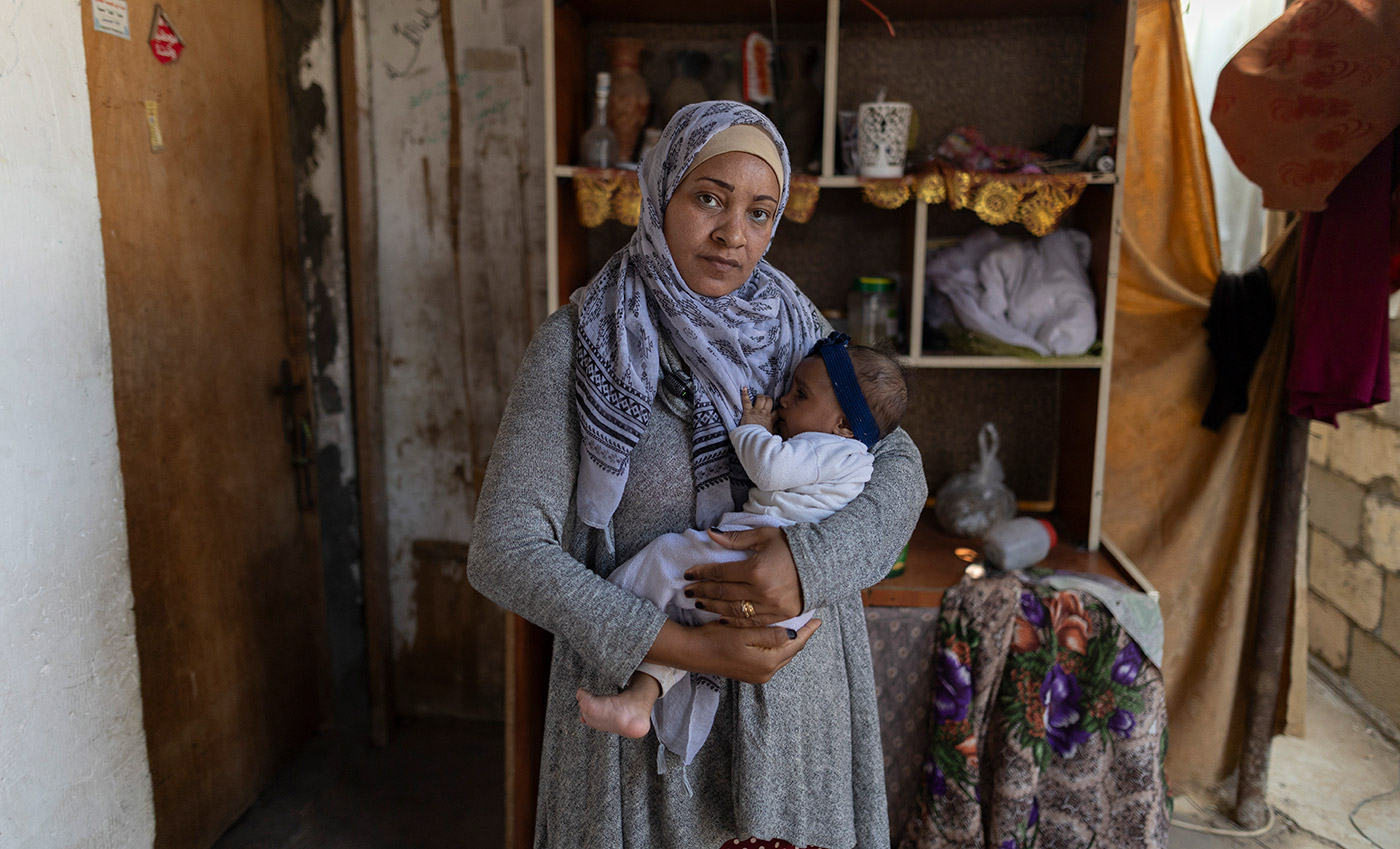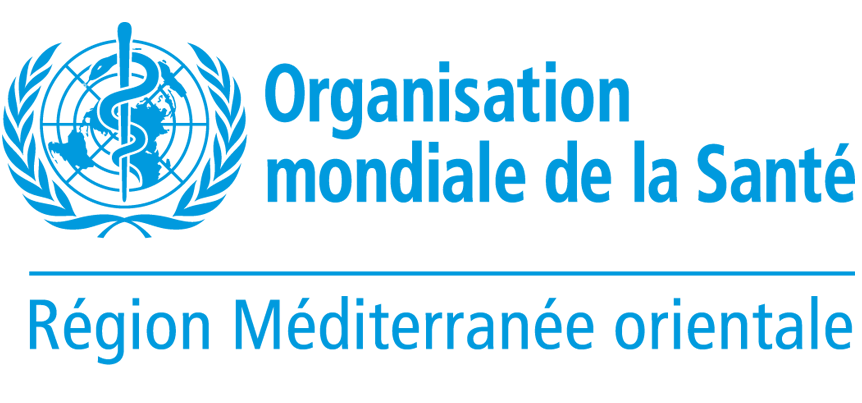Ministry of Health Inaugurates First Rehabilitation Outpatient Centers in West Bank with Funding from the Republic of Korea and Support from WHO and UNOPS
 6 May 2025, Ramallah - Two new state-of-the-art physical rehabilitation outpatient centers in Ramallah and Qabatiya governorates of the West Bank were inaugurated today, with the presence of the Palestinian Minister of Health, Head of the Representative Office of the Republic of Korea, Korea International Cooperation Agency (KOICA) Country Director, World Health Organization (WHO) Representative, and United Nations Office for Project Services (UNOPS) Director. These are the first outpatient rehabilitation facilities in the West Bank to be fully integrated into the public health system and operated by the Palestinian Ministry of Health.
6 May 2025, Ramallah - Two new state-of-the-art physical rehabilitation outpatient centers in Ramallah and Qabatiya governorates of the West Bank were inaugurated today, with the presence of the Palestinian Minister of Health, Head of the Representative Office of the Republic of Korea, Korea International Cooperation Agency (KOICA) Country Director, World Health Organization (WHO) Representative, and United Nations Office for Project Services (UNOPS) Director. These are the first outpatient rehabilitation facilities in the West Bank to be fully integrated into the public health system and operated by the Palestinian Ministry of Health.
The establishment of the rehabilitation facilities has been implemented jointly by the WHO and UNOPS, under the leadership of the Ministry of Health (MoH), with funding provided by KOICA.
Until now, access to rehabilitation services across the West Bank has been severely limited, with less than one rehabilitation bed per 100,000 people, and most services delivered only by nongovernmental organizations. Meanwhile, the number of individuals requiring rehabilitation continues to grow. Ongoing hostilities and violence have resulted in increasing numbers of patients suffering from traumatic injuries, while chronic diseases such as diabetes, stroke, and cardiovascular conditions have led to a rise in physical and neurological impairments.
The new centres were established to meet this growing need for specialized neurological rehabilitation services, with a focus on adults suffering from stroke, traumatic brain injuries, Parkinson’s disease, multiple sclerosis, and other neurological conditions. In total, the centres will serve an estimated 700,000 residents across the two governorates and neighboring communities.
“Today marks the launch of a vital rehabilitation project that will leave a lasting impact on countless Palestinians,” said Dr Majed Abu Ramadan Minister of Health. “The opening of two new centers comes at a time of urgent need for physiotherapy and rehabilitation services. Through robust partnerships and a shared commitment, we can address the pressing challenges facing the Palestinian health sector and ensure that all people receive the care, dignity, and support they deserve.”
Twenty-eight professionals have been recruited by MoH to provide services at the centers. Each centre is staffed by multidisciplinary teams, including specialists in physical therapy, occupational therapy, speech therapy, and mental health, trained by WHO local and international consultants to deliver evidence-based rehabilitation interventions. WHO also supported the development of operational guidelines for the centres and equipped them with new medical devices.
“The launch of the first public rehabilitation outpatient centers in Palestine marks a significant and meaningful step forward in improving health care services and reflects the 20-year partnership between Korea and Palestine, grounded in our shared commitment to human dignity. At a time of great need, the Korean government, through KOICA, has been able to support the provision of essential rehabilitation services through the close collaboration of the Ministry of Health, WHO, and UNOPS. This project stands as a testament to what we can achieve through effective collaboration and long-standing partnership. I look forward to continuing this important cooperation to serve those who need it most,” said Mr Koh, Youngkul, Head of the Representative Office of the Republic of Korea.
“This centre is a turning point for rehabilitation services in the West Bank,” said Dr Richard Peeperkorn, WHO Representative for the occupied Palestinian territory. “It brings essential, life-changing care into the public health system and sets a precedent for how rehabilitation should be integrated across all levels of care. We are proud to support the Ministry of Health in collaboration with KOICA to make quality care accessible to those who have long gone without.”
“UNOPS is proud to have supported the Ministry of Health and KOICA in turning this initiative into a functioning reality,” said Ms. Karuna Herrmann, Director of the UNOPS Jerusalem Office. “Our role focused on ensuring high-quality infrastructure, and coordinated delivery — the building blocks that make sustainable public rehabilitation services possible.”
Each centre is expected to deliver 50-60 therapeutic rehabilitation sessions per day, or 250–300 sessions weekly, providing individualized programmes that focus on restoring function, promoting independence, and improving patients’ overall quality of life. By bridging the gap in outpatient neurorehabilitation services in the northern and middle West Bank, these centres will contribute not only to clinical recovery, but also to broader goals of community reintegration and inclusive health development.
Mass polio vaccination campaign to continue in the Gaza Strip

19 February 2025, The emergency polio outbreak response in the Gaza Strip is continuing, with a mass vaccination campaign scheduled from 22 to 26 February 2025. The novel oral polio vaccine type 2 (nOPV2) will be administered to over 591,000 children under 10 years of age to protect them from polio. This campaign follows the recent detection of poliovirus in wastewater samples in Gaza, signaling ongoing circulation in the environment, putting children at risk.
Pockets of individuals with low or no immunity provide the virus an opportunity to continue spreading and potentially cause disease. The current environment in Gaza, including overcrowding in shelters and severely damaged water, sanitation, and hygiene infrastructure, which facilitates fecal-oral transmission, create ideal conditions for further spread of poliovirus. Extensive population movement consequent to the current ceasefire is likely to exacerbate the spread of poliovirus infection.
Two previous vaccination rounds in the Gaza Strip were successfully conducted in September and October 2024, reaching over 95% of the target. As poliovirus is found to remain in the environment, additional vaccination efforts are needed to reach every child and strengthen population immunity. The presence of the virus still poses a risk to children with low or no immunity, in Gaza and throughout the region.
In 2024, health workers faced significant challenges accessing certain areas of central, north and south Gaza, which required special coordination to enter during the conflict. In inaccessible areas such as Jabalia, Beit Lahiya, and Beit Hanoun where humanitarian pauses for the vaccination campaign were not assured, approximately 7,000 children missed vaccination during the second round. The recent ceasefire means health workers have considerably better access now.
No additional polio cases have been reported since a ten-month-old child was paralyzed in August 2024, but the new environmental samples from Deir al Balah and Khan Younis, collected in December 2024 and January 2025, confirm poliovirus transmission. The strain detected is genetically linked to the poliovirus detected in the Gaza Strip in July 2024.
The upcoming vaccination campaign aims to reach all children under 10 years of age, including those previously missed, to close immunity gaps and end the outbreak. The use of the oral polio vaccine will help end this outbreak by preventing the spread of the virus. An additional polio vaccination round is planned to be implemented in April.
The campaign will be led by the Palestinian Ministry of Health and implemented with support from the World Health Organization (WHO), United Nations Children’s Fund (UNICEF), United Nations Relief and Works Agency for Palestine Refugees (UNRWA) and other partners.
Polio vaccines are safe and there is no maximum number of times a child should be vaccinated. Each dose gives additional protection which is needed during an active polio outbreak.
WHO, UNICEF, and partners welcome the recent ceasefire and urge for a lasting ceasefire that leads to long-term peace.
Humanitarian access improves quality of polio vaccination campaign in the Gaza Strip
 28 February 2025, A five-day mass polio vaccination campaign in the Gaza Strip concluded on Wednesday, reaching nearly 603 000 children under 10 years of age with novel oral polio vaccine type 2 (nOPV2) following comprehensive, simultaneous access to all five governorates during the ongoing ceasefire. The campaign was conducted as part of emergency efforts to end an ongoing poliovirus outbreak and prevent further spread in the Gaza Strip.
28 February 2025, A five-day mass polio vaccination campaign in the Gaza Strip concluded on Wednesday, reaching nearly 603 000 children under 10 years of age with novel oral polio vaccine type 2 (nOPV2) following comprehensive, simultaneous access to all five governorates during the ongoing ceasefire. The campaign was conducted as part of emergency efforts to end an ongoing poliovirus outbreak and prevent further spread in the Gaza Strip.
During this round, an additional 40 000 children were vaccinated as compared to the previous two rounds conducted in September and October 2024, after poliovirus was detected in the Gaza Strip. The ceasefire enabled health workers to reach more children who had missed vaccinations due to displacement during the phased approach, living in areas that previously required special coordination for access, or being unreachable during the October 2024 round due to insecurity in North Gaza, including Jabalia, Beit Lahiya, and Beit Hanoun.
Strong community engagement and awareness of vaccination benefits had maintained high immunization rates in the Gaza Strip, where 89% of children received the third dose of oral polio vaccine in 2023, before the conflict. This round drew upon 1660 vaccination teams, 1242 of which were mobile, and deployed 1242 social mobilizers. Despite bad weather conditions, families welcomed the initiative and brought their children to points where they could receive the polio vaccine.
The campaign was conducted by the Palestinian Ministry of Health and implemented with support from the World Health Organization (WHO), the United Nations Children’s Fund (UNICEF), the United Nations Relief and Works Agency for Palestine Refugees (UNRWA), and other partners.
As part of the Global Polio Eradication Initiative’s commitment to mount a robust poliovirus outbreak response, surveillance for disease in children and for virus circulation in the environment has also been intensified since July 2024. It was this timely surveillance that detected ongoing environmental circulation of the virus, and the need to conduct additional vaccination to protect children.
As the ceasefire provides an opportunity to resume critical public health functions, working to recover Gaza’s previously strong disease surveillance and routine immunization are the best ways to protect children from polio and other vaccine-preventable diseases. Ending polio hinges on fully vaccinating every last child with polio vaccines. Ensuring uninterrupted access to safe water, sanitation and hygiene, and proper nutrition will protect children from many diseases including polio.
WHO, UNICEF and partners continue to call for a lasting ceasefire that leads to long-term health and peace.
Healthy Beginnings, Hopeful Futures - On World Health Day WHO calls for an immediate ceasefire in Gaza

Jerusalem, Cairo, Geneva, 7 April 2025 - On World Health Day, with the theme “Healthy beginnings, hopeful futures,” the Gaza Strip continues to be one of the most dangerous places to be a child and where pregnancy is clouded by fear due to ongoing violence, displacement and lack of medical access.
Between 18 March and 4 April 2025, since the resumption of hostilities, reportedly more than 500 children and 270 women have been killed. No aid has entered Gaza since 2 March 2025, deepening the hunger and malnutrition crisis, leaving families without clean water, shelter, and adequate health care, and increasing the risk of disease and death.
An estimated 55 000 women are pregnant in Gaza, with one third facing high-risk pregnancies. Around 130 babies are born each day, 27% by caesarean. Approximately 20% of newborns are pre-term, underweight, or born with complications, needing advanced care that is rapidly diminishing.
The fragile health system is overwhelmed by the influx of casualties, including among children. Essential medicines, trauma and medical supplies are rapidly running out, threatening to reverse hard-won progress rehabilitating hospitals and keeping them operational. Evacuation orders and attacks on health further restrict access to health care and risk closure of hospitals and medical facilities.
Due to the aid blockade, WHO’s supplies for maternal and child health, including for cesarean sections, anesthesia for delivery and pain management, intravenous fluids, antibiotics, and surgical sutures, are critically low. Blood units needed for complicated deliveries are in extremely short supply. Partners report that essential equipment and medicines, such as portable incubators, ventilators for neonatal intensive care, ultrasound machines, and oxygen pumps, along with 180 000 doses of routine childhood vaccines — enough to fully protect 60 000 children under the age of two — have not been permitted to enter, leaving ill newborns and young children without the life-saving care they urgently need.
The food shortage is deepening the crisis and threatens to reverse the progress made in food security during the ceasefire. Mothers and children are hit hard. A recent Nutrition Cluster analysis found that between 10 to 20% of 4500 surveyed pregnant and breastfeeding women are malnourished. The closure of 21 outpatient malnutrition treatment sites, due to insecurity or evacuation orders, has disrupted life-saving care for over 350 acutely malnourished children and has severely limited the ability to detect and treat new cases.
Despite security risks and access restrictions severely hampering WHO’s response, efforts to support health facilities and strengthen maternal and child health services continue amid dwindling supplies. Focus is on the delivery of essential medicines, equipment, and supplies, training of health workers, and deploying emergency medical teams to enable safe deliveries and care for sick children.
WHO urgently calls for the lifting of the aid blockade, the protection of health care, unimpeded humanitarian access across Gaza, the immediate resumption of daily medical evacuations, release of hostages, and a ceasefire that paves the way for lasting peace.
Related links
https://www.who.int/emergencies/situations/conflict-in-Israel-and-oPt








